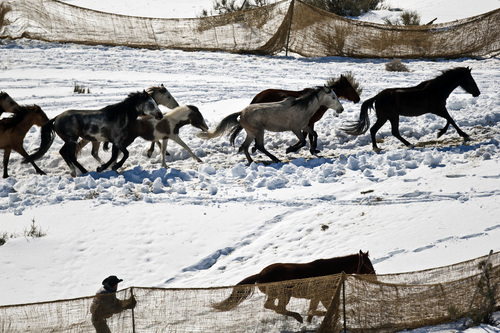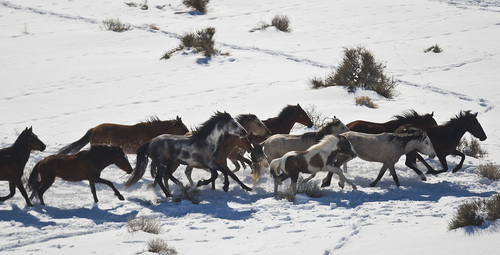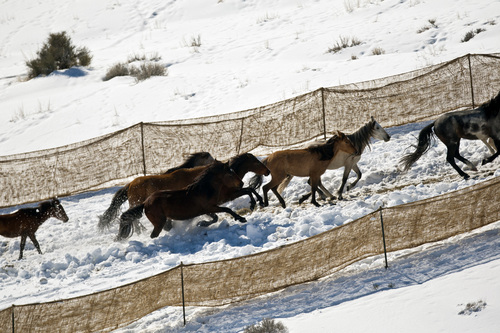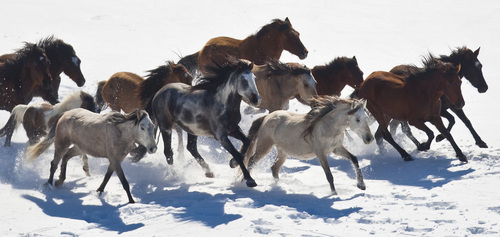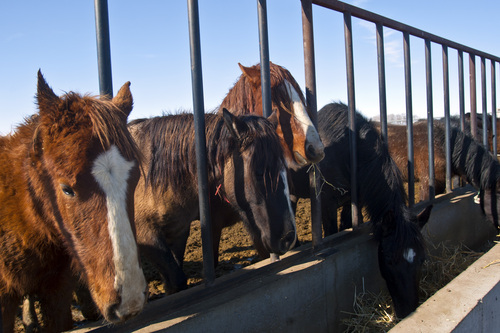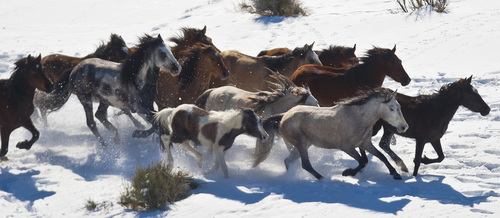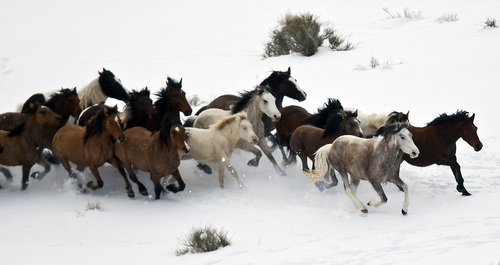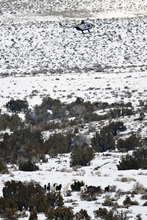This is an archived article that was published on sltrib.com in 2014, and information in the article may be outdated. It is provided only for personal research purposes and may not be reprinted.
Negotiations are on in the brewing battle over wild horses in southwestern Utah, but so is the threat of a drought-inspired emergency roundup.
Iron County leaders reported Friday that the Bureau of Land Management has responded to their ultimatum to reduce the overpopulation of wild horses in the area, but they are still considering corralling the animals themselves.
"The state BLM director said he received communications from the Washington office that, based on the direction Iron County is taking, that rather than be an adversary that they should work with us," County Commissioner Chairman David Miller said Friday morning. "They are working to get us a formalized statement that will help us get the population to the appropriate levels. But we are not calling off the cavalry. We are still putting together our own plan."
The commission presented the BLM with a letter earlier this week warning the federal land agency to reduce the number of wild horses on the western edge of the county or it would. The deadline of high noon Friday came and went without any signs of roundups from either the county or the BLM.
County officials complain the horses are wreaking havoc on range shared by native wildlife and cattle on BLM-permitted land. The Utah office of the BLM has estimated 1,200 horses are spread over several management units. The agency's own plans call for 300.
"In concept, we are all working toward the same goal: a shared responsibility for this wonderful icon of the West," said Juan Palma, BLM's Utah director, who mentioned Beaver County officials have also been involved in the discussions. "We have an agreement in concept, but it is not yet completely defined."
Palma said the BLM has some legal processes to work out. He explained that if a roundup takes place, horses would be held on property volunteered by a rancher, and the federal agency would provide supervision and feed for the animals until they could be adopted or moved to other facilities.
"We can provide our experience of doing roundups for years," he said. "Our biggest concern with the public aspect of it is the possibility of someone getting hurt. We don't want that to happen."
Palma emphasized that the agency has "concerns for the horses as well."
"We will provide accountability throughout the process with strong oversight and responsibility. We know there are people out there concerned for the wild horses, and we will treat them well."
He worries, for instance, that the mares are giving birth this time of year, so extra care would need to be taken in any roundup.
Palma plans to send a more formal proposal to Miller and suggests the county provide three people and the BLM three people to attend a meeting early next week to determine the logistics of any roundups.
"We are pleased with Juan and his leadership. We feel like we are all of the same spirit to do the right thing for everybody, including the horses," Miller said. "But we aren't going to wait around."
County commissioners and ranchers are not the only ones concerned about the high numbers of wild horses in the West Desert.
Utah wildlife officials worry about their impact on other species. Wild horses and burros are not recognized as wildlife in Utah because the Wild Horse and Burro Act made them a federally regulated species, said Bill Bates, chief of wildlife for the Division of Wildlife Resources.
Even so, biologists are aware of their presence.
"Anybody in land management recognizes wild horses do have a significant impact in some locations," Bates said. "In arid areas, where water is limited, they tend to camp out on springs and other sources."
Wild horses and burros also tend to bully other animals.
"It has been well documented," Bates said, "that bighorn sheep and other animals are less likely to go into springs or other water sources if there are horses there."
Bates said Utah biologists consider wild horses and burros when they work on management plans for other species and discuss the animals when they huddle with the feds.
"We are supportive of the BLM," he said, "but we would really encourage them to follow their management plans."
It seems the threat by Iron County to do its own roundup and the drought have prompted the BLM to step up their efforts.
"The county and BLM have been talking about this issue for some time. What accentuated the topic was the drought conditions. It's a real problem," Palma said. "We need to protect the range from wild horses and other hoofed animals in these conditions. It is our responsibility to protect the range over the long term, and we need to do that by gathering some of the horses now."
National events on the wild horse front also surfaced Friday, when the BLM announced its priorities for fiscal year 2015 in President Barack Obama's requested $1.1 billion budget.
The spending plan seeks an increase of $2.8 million for the Wild Horse and Burro program. Part of the money would go toward continued studies of more effective and longer-lasting fertility-control practices for the animals.
The budget also calls on Congress to establisha nonprofit foundation for the BLM. The foundation could bring additional resources to important BLM initiatives such as wild horses.
Twitter: @BrettPrettyman —
Cedar City wild horse adoption
Horses from the BLM's Delta and Gunnison facilities will be available for adoption May 16-17 at the agency's Cedar City Corrals, 775 N. 100 East. Horses gathered as part of an emergency Iron County roundup, if it occurs, could also be available then. The horses can be adopted on a first-come, first-served basis for $125. Contact Chad Hunter at the BLM Cedar City Field Office, 435-865-3000, for details. More information is at http://tinyurl.com/bswp8ek.


